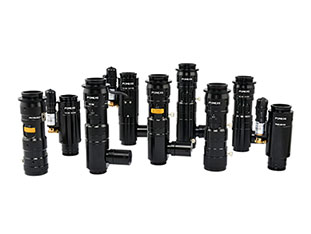In the field of machine vision and industrial photography, the zoom lens is an extremely important optical tool. Its unique design allows the lens focal length to be continuously adjusted within a certain range, thus adapting to different shooting needs and scenes. Understanding the general knowledge of zoom lenses is essential for selecting and using such lenses.

The importance of zoom lenses
The main advantage of zoom lenses is their flexibility. By adjusting the focal length, a photographer or machine vision system can easily image objects at different distances clearly without changing lenses. This feature is especially useful in application scenarios that require frequent adjustments to the shooting distance or angle of view, such as product inspection on production lines and outdoor surveillance.
Characteristics of the zoom lens:
1. Adjustable focal length: the focal length of the zoom lens can be continuously changed within a predetermined range, usually by rotating the zoom ring on the lens to achieve.
2. Angle of view change: with the change in focal length, the angle of view of the lens will change accordingly. The long focal length end provides a narrower angle of view and greater magnification, suitable for shooting long-distance objects; while the short focal length end provides a wider angle of view and smaller magnification, suitable for shooting large scenes.
3. Aperture adjustment: In order to maintain proper exposure at different focal lengths, zoom lenses are usually equipped with an adjustable aperture. As the focal length changes, the photographer needs to adjust the aperture size accordingly to ensure the clarity and brightness of the image.
4. Image quality and stability: high-quality zoom lenses can maintain relatively stable image quality throughout the zoom range, reducing optical problems such as distortion and dispersion.
Considerations for selecting and using zoom lenses:
① Focal Length Range: Select the appropriate focal length range according to actual needs to ensure that the lens can meet the expected shooting distance and angle of view changes.
② Image quality: Choose a high-quality zoom lens to ensure clear, sharp images throughout the zoom range.
③ Aperture and shutter speed: Pay attention to the lens' aperture and shutter speed performance at different focal lengths to ensure proper exposure and image quality.
④ Stability and durability: For application scenarios that require frequent focus adjustments, it is important to choose a zoom lens that is structurally stable and durable.
With its unique flexibility and wide range of application scenarios, the zoom lens has become an indispensable optical tool in the field of machine vision and industrial photography. Understanding its common sense and selection and use considerations will help to better utilize its advantages in various application scenarios.
Product recommendation
TECHNICAL SOLUTION
MORE+You may also be interested in the following information
FREE CONSULTING SERVICE
Let’s help you to find the right solution for your project!


 ASK POMEAS
ASK POMEAS  PRICE INQUIRY
PRICE INQUIRY  REQUEST DEMO/TEST
REQUEST DEMO/TEST  FREE TRIAL UNIT
FREE TRIAL UNIT  ACCURATE SELECTION
ACCURATE SELECTION  ADDRESS
ADDRESS Tel:+ 86-0769-2266 0867
Tel:+ 86-0769-2266 0867 Fax:+ 86-0769-2266 0867
Fax:+ 86-0769-2266 0867 E-mail:marketing@pomeas.com
E-mail:marketing@pomeas.com
